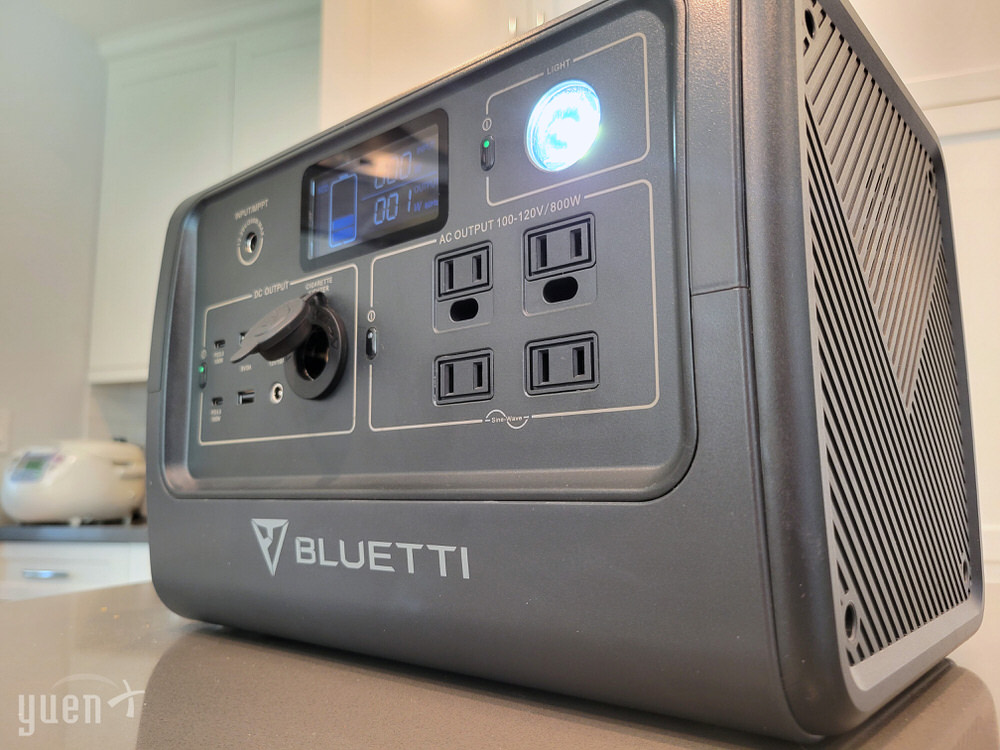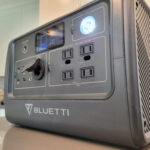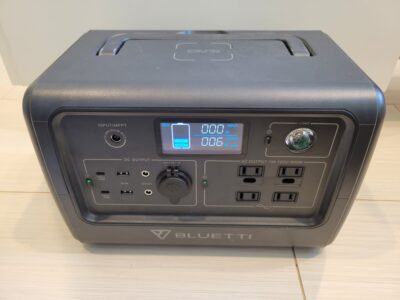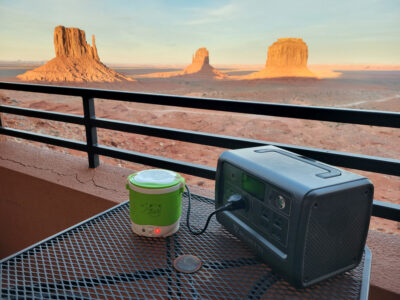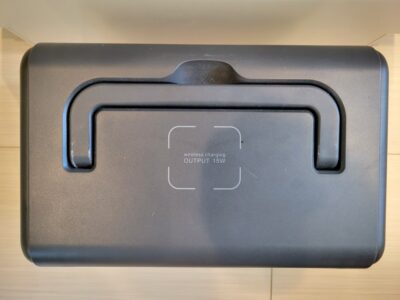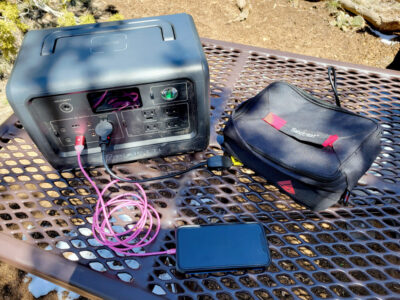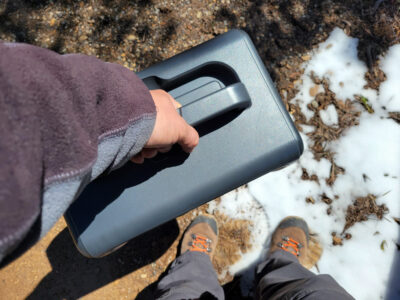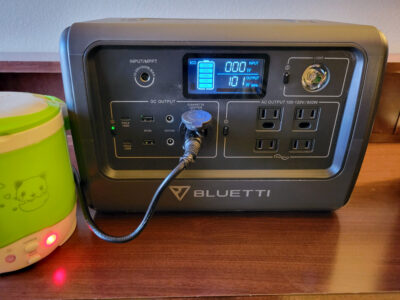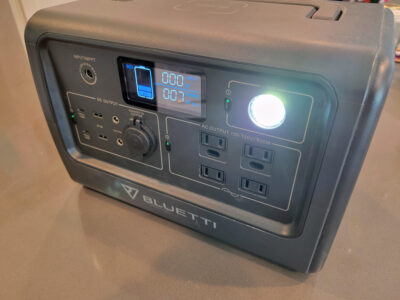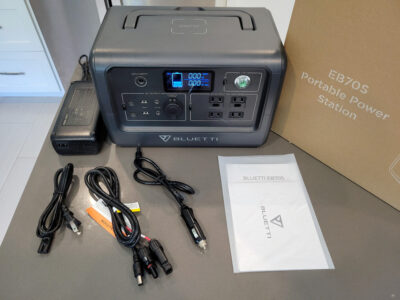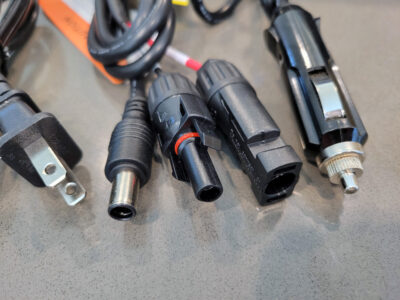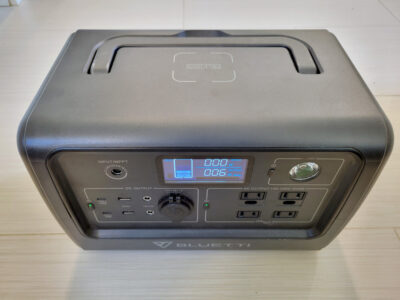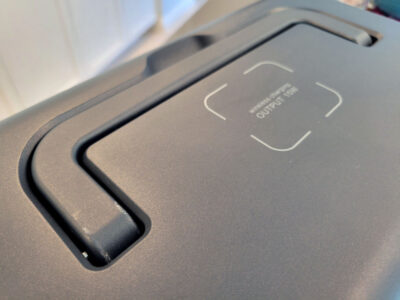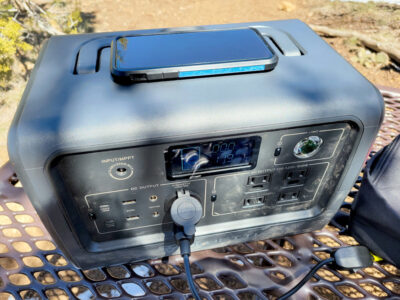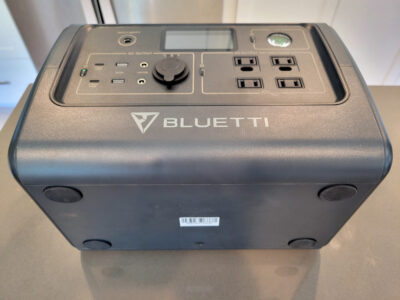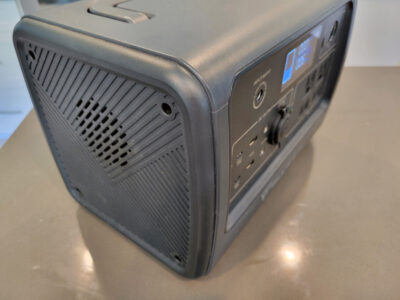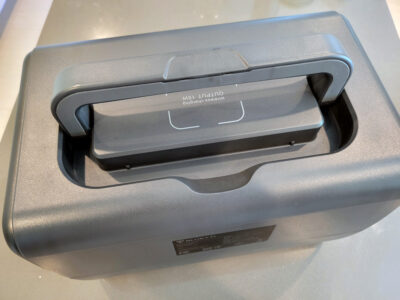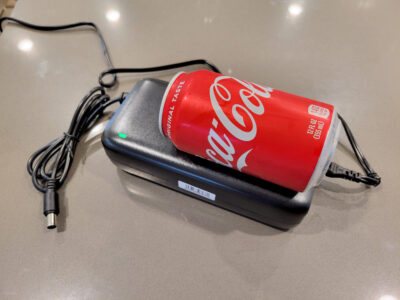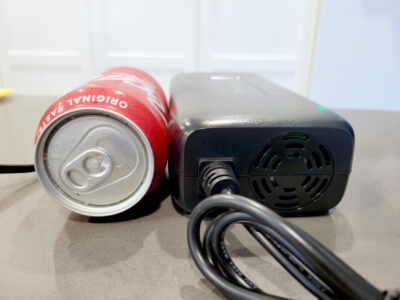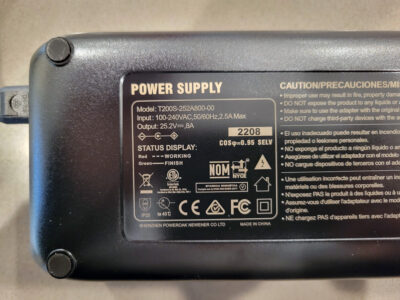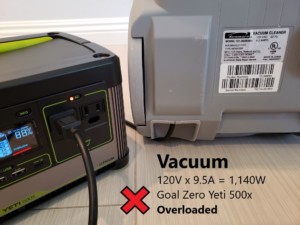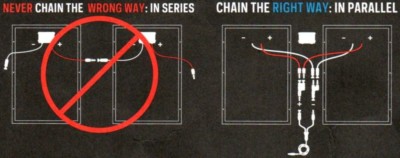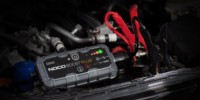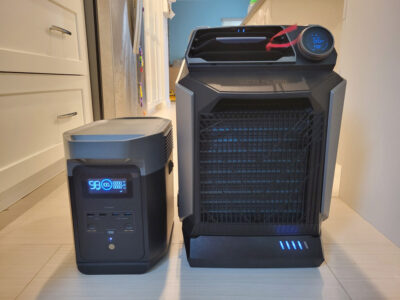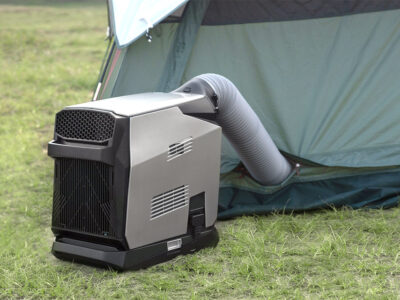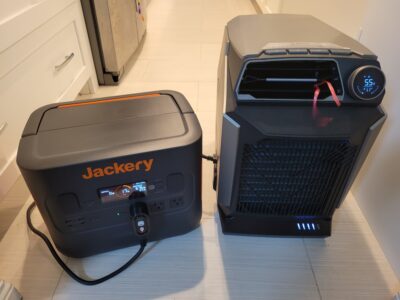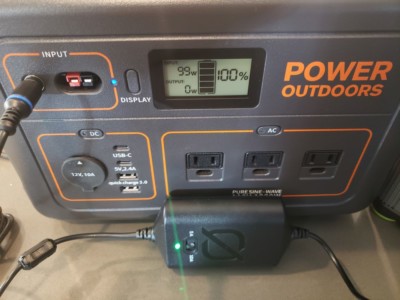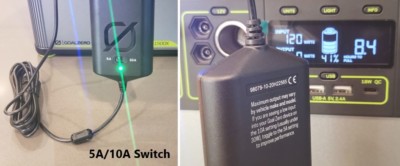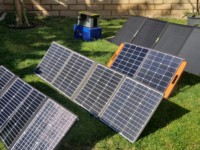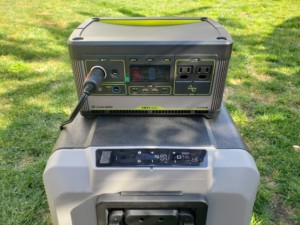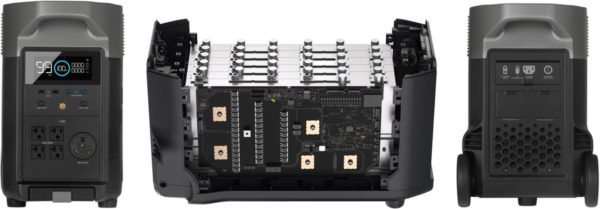Contents
Introduction
Goal Zero, Jackery, EcoFlow, and Bluetti are the four best-known power station brands that come to mind among my fellow outdoor enthusiasts and emergency preppers. Goal Zero had been the global market leader, but as of late, their products have started to lag behind innovative ones from EcoFlow, such as their Delta Pro power station and Wave portable air conditioner, and even Jackery who had traditionally been focusing on standalone power stations. The latter has no home integration kit or expansion options available, for example, but their latest Explorer 2000 Pro has some nice features that none of the Goal Zero Yeti X offer. They even announced the Air-W wind-powered turbine, but like EcoFlow, neither company had yet brought them to market.
One of the most requested products that readers had asked me to review was the Bluetti EB70S (Amazon | Bluetti), a 716Wh power station released around May 2021. I picked one up on sale for a friend despite it being two years old as he already had Bluetti solar panels and wanted to eventually install one of their Home Battery Backup systems. The 716Wh battery capacity was interesting: most products I had tested were either 500Wh or 1,000Wh — hardly any smack middle between the two sizes.
Three features immediately stood out:
- LiFePO4 battery chemistry
- Bluetti brand name and widely well-regarded
- Good pricing (especially when it was on sale)
In this review, we will loosely compare the Bluetti EB70S with an EcoFlow Delta 2, Goal Zero Yeti 1000x / 1000 Core, and Jackery Explorer 1000. I said “loosely” because the other manufacturers’ have 30% more capacity with their 1,000Wh products. So, we will focus mostly on the feature sets and technologies and not so much have an apple-to-apple battery capacity comparison.
Analysis
The Bluetti EB70S, like EcoFlow’s newer products, uses the Lithium-ion LiFePO4 (Lithium Iron Phosphate) battery chemistry over the Lithium-ion NMC (Nickel Manganese Cobalt). Both have their pros and cons that we will go over later in this review. Competitors Goal Zero and Jackery had continued focusing on NMC for its smaller size and lighter weight, although the latter released their first LiFePO4 model in mid-June 2023.
Lithium-ion NMC batteries are lighter and smaller, but more volatile and pricier, less usable in extreme temperatures, and have a lower charge cycle count (battery lifetime) than LiFePO4.
At first sight, the Bluetti looked well-built with a good amount of output options, including 4 AC outlets (2 of which were grounded), covered 12V port, 2 USB-C PD 100W for power-hungry laptops, 15W wireless charging pad at top, flashlight (like the Jackery Explorer 1000), and more. The flashlight’s SOS function blinked the right morse code, and a collapsible carry handle was a welcome feature that many manufacturers neglect. Like Jackery and EcoFlow, Bluetti used a hardshell plastic exterior to save weight. I am not sure if this was intended, but the side grilles where the fans are mounted to cool down the unit look like the triangular symbol part of the company’s logo.
Battery capacity was 716Wh and more than enough for 1.5-2 days of powering a car freezer, and about 10 hours of a 60W/hour-consuming CPAP machine. See the “Calculations” section below for details on how long an electronic device could be powered for with this battery. The manufacturer could not or would not tell me who made their battery cells.
The AC outlets were capable of 800W of continuous, pure sine wave output (up to 1,400W peak) — enough to run an 800W miter saw with. See the “Continuous vs Peak Output” section below for why these two numbers matter, or look at our Ultimate Power Station Reference for comparing different power stations’ capabilities. In essence, the Bluetti EB70S was more powerful than the Jackery Explorer 500 and Goal Zero Yeti 500x, but keep in mind that they were lower capacity at 500Wh (compared to the Bluetti’s 716Wh). On the other hand, the (1,000Wh) Goal Zero Yeti 1000x, Yeti 1000 Core, and Jackery Explorer 1000 Pro have higher-end features and capabilities. In either case, because the EB70S sat smack-middle between the 500Wh and 1,000Wh batteries, an apple-to-apple comparison could not be made.
How much power is used or produced is measured in Watts (W), and how much energy a battery can store is calculated in Watt-Hours (Wh).
Its blue backlit display features the usual metrics one would expect for power stations made a few years ago: input and output wattages and battery level. Today’s higher-end batteries use colorful displays that are both beautiful and easier to read in direct sunlight.
The EB70S performed beautifully and reliably during our nine-day road trip across the Grand Circle Tour covering six States. It powered our Costway Dual-Zone Car Freezer every single day and night during that time period and was also used to cook some rice and sausages at Monument Valley, Arizona. If the battery level had dipped to below 20%, I had confidence that it could be recharged quickly through the AC wall outlet at a speedy 195W — or roughly 4 hours from empty to full. Keep in mind that power stations in general, this Bluetti included, start to slow down the rapid-charging speed once 75% is reached and then crawl their way to 100% to protect the battery cells. The EB70S can be used while charging itself.
CAUTION: Lithium-ion (LiFePO4 and NMC) batteries do NOT like to remain discharged at 0% for prolonged periods of time. If you let your battery stay at 0% for too long, you may not be able to charge it again without specialized equipment.
Speaking of quick-charging with a wall outlet: the AC power brick (200W, 25.2V @ 8A) was noticeably more massive than Godzilla roaming through the streets of Tokyo. It shockingly had its own, built-in fan and — when coupled with the EB70S’s own fans — roared just as loud as the legendary monster while charging. It was perhaps my biggest gripe with this unit as those who value silence may find the noise a non-starter.
The 8mm input/MPPT (solar charging) port was the same as the Goal Zero Yeti X series and old-style Jackery Explorer 1000 power stations: DC7909. As such, those competitors’ solar panels and Goal Zero’s excellent 120W car charger (Goal Zero | Amazon) could interchangeably be used. Bluetti included an 8mm-to-MC4 adapter for up to 200W of solar charging.
Under the hood, the 21.4 lbs @ 12.6″ L x 8.5″ W x 8.7″ D made the EB70S weigh and almost be dimensionally the same as the larger-capacity Jackery Explorer 1000 (1,002Wh Li-ion NMC). The Bluetti was offered in three color choices: Mint Green, Steel Gray, and Carmine. The striking Carmine blue was my favorite, but my friend wanted the Gray.
Bluetti sells an ecosystem of products that allow its power stations to be expanded (like Goal Zero and Ecoflow) with its Smart Home Panel. However, the EB70S was a standalone product meant for portability and not as a home backup. There also was no mobile app support due to not having WiFi or Bluetooth. That was a shame as neither remote control nor firmware updates were available to provide fixes or feature enhancements.
Overall, the two-year old Bluetti EB70S (Amazon | Bluetti) had been a reliable power station that had forward-looking features and capabilities for its time: enough power and capacity for a mobile warrior, a solid number of output ports, rapid charging, and professional-looking design. Its biggest downfall, however, was the large AC power brick and the fan noise produced by both the charger and the power station itself. If you can go past that, then the EB70S could be a compelling battery with its relatively low price (one of the least expensive LiFePO4 out there), especially when on sale.
What’s Good? What’s Bad?
Pros
- Good battery capacity (716Wh)
- Fast charging at up to 200W (4 hours from AC wall)
- Can be used while charging (pass-through UPS), though that can shorten the battery’s lifetime
- Li-ion LiFePO4 battery chemistry provides 10+ years of continuous power
- Up to 2,000 – 3,000 cycles based on my research
- Much safer and stable than Li-ion NMC
- Inexpensive: one of the lowest-costing Li-ion LiFePO4 power stations available
- Low discharge rate when idle or in storage
- Good AC inverter with continuous 800W (1,400W peak) of output
- Enough to power small appliances, including some miter saws, projector, CPAP, or portable AC (such as the EcoFlow Wave)
- 4 AC output ports
- Pure-Sine Wave AC Inverter
- Clean power for sensitive electronics
- Less heat
- Note: Some manufacturers claim to be Pure-Sine when they are actually Modified or Square Waves
- MPPT solar charging (at up to 200W)
- Much more efficient for charging than the older PWM technology
- 8mm (DC7909)-to-MC4 solar adapter cable included
Tip: It is possible to get multiple companies’ products (battery power stations and solar panels) to work with one another once you understand the different connector types, such as Anderson APP, MC4, 8mm, and so on. In one test, I had simultaneously connected solar panels by Goal Zero, Jackery, Suaoki, and Paxcess to the Yeti 1500x’s Anderson port to collect energy from all four!
- Quality BMS (Battery Management System) for safety
- Provides built-in overload, overcharge (automatic stop when the device is full), and short-circuit protection
- Silent when power station is not being charged
- DC Output Ports
- 4x USB
- 2x USB-A at 15W (5V @ 3A)
- 2x USB-C PD at 100W (Power Delivery for use by devices like laptops)
- 2x DC5521 at 120W (12V @ 10A)
- Car outlet at 120W (12V @ 10A)
- 4x USB
- Wireless charging at 15W, but keep in mind that this method is always less efficient than connecting directly with a cable
- Foldable carry handle is strong, but not enough to run a cable lock through for theft deterrence (handle could be yanked out of the enclosure)
- Relatively small at 12.6″ L x 8.5″ W x 8.7″ D
- Built-in light with 2 intensity levels and SOS signaling
- 3 color choices: Mint Green, Steel Gray, Carmine (blue)
- Monochrome LCD display that can be read under the sun
Cons
- Noisy while charging
- Power station and AC brick have built-in fans that activate during charging. The EB70S is silent when not charging
- Large AC power brick
- Somewhat heavy at 21.4 lbs, but to be expected for a 716Wh battery
- Plastic enclosure helps shed some weight but is not as heavy-duty as Goal Zero’s Yeti X line
- No Anderson Power Pole (APP) for solar charging with a standard input
- No mobile app (WiFi or Bluetooth) for remote control or firmware upgrades
- No home or vehicle integration kit
- Battery not replaceable like the older Goal Zero Yeti 1400 Lithium
- Leads to landfill/environmental waste. Please recycle responsibly!
- Not waterproof. Keep it away from water splashes, rain, and pool!
Usage
- Turn off any output ports (AC/DC) that are not being used in order to conserve power
- Without anything plugged in, the AC inverter still draws 7W on its own
- To prolong the battery lifetime while in storage, keep the battery fully charged every 3-6 months
- Or, according to some companies, including Goal Zero, keep it plugged in when not in use and discharge it to 50% every 3-4 months
- The charging controller automatically gets disabled once the battery is full
- You may also charge it to 80% for storage, but be sure to discharge to 20% every 3-4 months
- NOT using the battery for a very long time can actually hurt its lifetime
- There is no “memory effect” in this station’s battery
- Note: It is better to NOT let it completely drain before recharging
- Battery, like all LiFePO4 and NMC, slowly drains over time even when station is powered off
- Could take 1-1.5 years to go from full to empty
- There is no “memory effect” in this station’s battery
- Or, according to some companies, including Goal Zero, keep it plugged in when not in use and discharge it to 50% every 3-4 months
CAUTION: Lithium-ion (LiFePO4 and NMC) batteries do NOT like to remain discharged at 0% for prolonged periods of time. If you let your battery stay at 0% for too long, you may not be able to charge it again without specialized equipment.
Continuous vs Peak Output
It is important to understand the difference between Watts and Watt-Hours. How much power is used or produced is measured in Watts, and how much energy a battery can store is calculated in Watt-Hours. See the “Calculations” section below for more details.
How much energy a battery can store is measured in Wh (Watt-hours), and how much power is used or produced in W (Watts).
- AC Inverter: Converts battery (DC) power into AC
- Bluetti EB70S provides 800W continuous output with a 1,400W peak
- Peak/Surge (Starting): Nearly every device initially draws extra power to turn on. The highest amount it pulls is the Peak. As long as that number is below 1,400W, it can be STARTED
- Turns on OK (PEAK under 1,400W):
- Freezer starts at 400W (peak), runs at 150W once on
- Coffee maker starts at 1,400W (peak), runs at 800W once on
- Will NOT turn on (PEAK over 1,400W):
- A heavy-duty tool starts at 1,900W (peak), runs at 1,200W once on
- Turns on OK (PEAK under 1,400W):
Most devices power on at a higher (Peak) wattage than when they are already on (Continuous). Therefore, if its peak exceeds the power station’s max, it may not be able to start.
- Continuous Output (Running): Once devices are on, as long as they keep drawing less than 800W total, they will stay ON until the battery runs out
- CONTINUES running (under 800W)
- 100W TV + 60W laptop = 160W
- COULD STOP running (over 800W)
- Temporary overdrawing beyond 800W for a few seconds is okay. A quality BMS will protectively shut down the battery if the surge does not end after a while. Regularly going over for a prolonged time can ruin the battery in the long run
- 800W Coffee maker (1,400W peak) + 45W Car Freezer = 845 W. Probably will stay on for a short period
- Add 100W TV (120W peak) = 945W. Battery will definitely shut down
- CONTINUES running (under 800W)
Solar Panel – Warning
This power station can be charged with one or more solar panels as described in the “Ports > Input” section. There are SOME PRECAUTIONS you must take to minimize battery damage and/or injury to life/property:
- Never exceed the maximum Voltage (V) or Amperage (A) of the power station’s charging port
- If you want to use 2+ solar panels to charge faster:
- Do not mix them with different V or A as the output might get reduced (less energy generated)
- Do not daisy-chain them in sequence/series as that can exceed the power station’s maximum V or A
- Always connect them in PARALLEL with a Y-branch or Combiner cable
- Keep the battery out of direct sunlight while charging. You may have to use an extension cable to keep it in the shade
Wondering what size solar panel to get? See the “Calculations” section below.
Calculations – Size & Time
What size battery should you get? How long will it power your fridge for? How long will it take to recharge? The below calculations can help answer those questions and are rough ESTIMATES as conditions, battery quality, and age can vary.
Time to Charge Battery
- Calc: Hours to charge battery = Battery capacity (Wh) / Input Wattage
- Note: As battery approaches 75% full, the input charge will increasingly be slowed down to prevent overcharging
- AC Wall: 200W @ 3.6 hrs [716 Wh / 200W]
Charge Time with Solar
- Calc: Hours to charge battery = Battery capacity (Wh) / (Panel Wattage x [0.5 or 0.75])
- In a perfect lab environment, solar panels charge at the listed wattage
- Expect to only receive 50-75% on a good, sunny day (ie. 75W – 113W for a 150W panel), depending on panel’s age, component quality, and weather
- Two 100W solar panels: as fast as 4.8 hours [716Wh / (2 x 100W x 0.75)]
- Tips
- Keep charging even when overcast as the panels will STILL collect energy
- Underproduction: If a 200W panel is not making enough (ie. only 50W) due to bad conditions, adding extra ones (ie. two more 200W) can generate a higher, combined output (ie. 50W + 110W from the two panels = 160W total)
- Overproduction: If the panels make more (ie. 400W) than the maximum the power station charge port can take (ie. 200W), only the max (ie. 200W) will go through
Watts Used/Produced
- Calc: Watts used or produced by device = Voltage x Amperage
- Vacuum with 120V @ 9.5A uses 1,140W
- Solar panel with 12V @ 10A can produce up to 120W
Ideal Battery Size
- Calc: Battery capacity (Wh) = Watts used by device x Hours needed for / 0.85
- 10-15% of power is lost during power conversion
- 45W car fridge needed for 8 hours: Minimum 424Wh power station (45W x 8 / 0.85)
How much energy a battery can store is measured in Wh (Watt-hours), and how much power is used or produced in W (Watts).
Time Before Battery is Empty
- Calc: Hours available for device = Battery capacity (Wh) x 0.85 / Watts used by device
- 10-15% of power is lost during power conversion
- 60W laptop with 716Wh battery: Up to 10.1 hours (716Wh x 0.85 / 60W)
Time to Charge Device
- Calc: Hours to charge device = Device’s battery capacity (Wh) / Input Wattage
- 60W laptop with 200Wh battery: Up to 3.4 hrs (200 Wh / 60W)
Conversion to mAh
- Calc: Powerbank-equivalent capacity (mAh) = Battery capacity (Wh) / Voltage x 1000
- 1 Ah = 1000 mAh
- Bluetti EB70S @ 3.7V = 193,513 mAh power bank (716 Wh / 3.7V x 1000) or 66,296 mAh @ 10.8V
Tips and Suggestions
Safety
- Always test your devices with the power station before you depend on it on the go
- Lithium-ion batteries are volatile
- To minimize fire damage to your belongings or loved ones, store the power station in the garage and not inside the house. Best storage is a dry, cool place
- You cannot bring a battery of this capacity on a plane
- With the right BMS, quality batteries, and other factors, the power station can be STORED in the car during hot temperatures
- Keep the battery out of direct sunlight. I usually store it on the floor of the car and crack open the windows a tiny bit
- Do not USE any power station in a tightly enclosed area as it can overheat
- Do not USE in the car if temperatures fall below or exceed the battery’s rated, operating temperature
- Car charger: Only use it while the car is RUNNING. Otherwise, you may deplete your car’s battery and leave you stranded
Jump Start Car?
A battery power station like this one cannot be used to jump start a car. Instead, I suggest getting a small, portable one specifically made for that, such as my favorite: NOCO Genius Boost Car Jump Starter (Lithium Battery).
Portable Air Conditioner
The EcoFlow Wave is a portable air conditioner that accepts both AC and DC input. The company, of course, recommends using its own Delta power stations for better efficiency and longer runtime because they can draw directly from DC power. In a pinch, any battery or generator capable of providing the Wave-required input wattage could be used, but keep in mind that AC power loses some energy due to conversion to DC.
Goal Zero 12V Car Charger
I wanted to point out how GAME-CHANGING the Goal Zero 12V Car Charger is (Buy on Goal Zero/Amazon). The company inexplicably does not promote its benefits enough, but it can be used to charge batteries at a whopping 120W when the car port supports 10A (like my Toyota Sienna and Highlander did!) All other car chargers I have (Jackery, Rockpals, Paxcess) only go up to 60W, but the Goal Zero can double that! What does that mean? Faster charging while driving around town! I bought two — one for use with the Yeti 1500x and another with the Jackery Explorer 1000.
The Goal Zero 12V Car Charger can charge a supported Goal Zero, Jackery, Bluetti, or EcoFlow battery at a whopping 120W!
Use With Other Brands
Nearly all of the leading power station manufacturers can be used with competing products or accessories — solar panels in particular.
As long as the panels or different Watt-capacities produce the same VOLTAGE, you will be able to safely use them with the Bluetti EB70S. However, be sure to NOT exceed the power station’s rated input Voltage or Amperage! All you would generally need to interconnect is to buy adapter cables that convert from MC4, APP, or other connector types to the Bluetti’s (8mm) DC7909 port.
I had previously tested my Goal Zero Yeti 1500x with the company’s own Nomad panel and those by Jackery, Paxcess, and Suaoki. It was a bliss in interconnectivity! What that means is that you can buy lower-priced solar panels that may produce the same capacity as those made by the power station’s manufacturer. You do not always have to buy their own branded products as long as the substitutes stay within the rated limits.
Final Thoughts
Bluetti launched the EB70S (Amazon | Bluetti) power station about two years ago, and despite technology having advanced quite a bit since, the product is still relevant today as a reliable, fast-charging battery for a multi-day road trip, depending on use cases.
As a standalone battery, the EB70S with its good AC inverter output was capable of powering a good amount of devices I could throw at it — without the noise and pollution of a gas generator. It also worked well with our EcoFlow Wave portable air conditioner and, separately, the Costway car freezer during a 9-day driving tour of some of America’s best national parks.
Its noise level could be an issue for some buyers during charging due to its own fans AND the power supply’s activating, but the power station was silent during discharge/regular use.
Nonetheless, the price was difficult to beat as it was one of the least expensive power stations available among Li-ion LiFePO4 units. Combine that with a safe, reliable, long-lasting battery chemistry, and the Bluetti EB70S is still a viable product today.
Where To Buy
- Bluetti
- Adapters
- SolarEnz 8mm-to-MC4 / iGreely 8mm-to-APP
- EcoFlow
- Jackery
- Goal Zero
Related Posts
- Power Generators: Gas vs Propane vs Battery Station (and Solar)
- Ultimate Reference: Power Station Comparison
- Reviews
- Jackery Explorer 2000 Pro / Explorer 1000 / Explorer 300
- Goal Zero vs Jackery: Yeti 1000 Core vs 1000X vs Explorer 1000
- Goal Zero Yeti 1500x / Yeti 1000x / Yeti 500x
- BigBlue Cellpowa500 LiFePO4
- Rockpals 500W / nrgGo 400
- EcoFlow Delta Pro LiFePO4
- EcoFlow Wave Portable Air Conditioner
- Quick Look
- Announcements
Other Useful Topics
Power Station Comparison
Check it out!
Ultimate Reference: Power Station Comparison – We summarized the specifications of many of the power stations we had come across or reviewed all in one place.
Gas/Propane Generators vs Battery Power Stations
In July 2020, I wrote about this topic after many asked what their differences were. In short, gas/propane generators can run virtually forever but are loud, dirty, and potentially quite dangerous. Battery power stations, on the other hand, are more portable, silent, less volatile, and can be operated indoor, but depend on external power (like solar) to recharge. Where gas/propane are used to GENERATE electricity, batteries STORE them for later use. Personally, I am a fan of the latter because they are so easy to carry around and are safer to use.
Battery Technology and Safety
Goal Zero debuted with Lead-Acid batteries that were bulky and heavy. Today’s devices use Lithium-ion — commonly Nickel Manganese Cobalt (NCM) or Lithium Iron Phosphate (LiFePO4 / LFP) chemistries — for more power in a smaller, lighter package. NMC, however, is more volatile than LiFePO4 and becomes riskier as more cells are packed together. Goal Zero and Jackery used NMC for some time whereas EcoFlow and Bluetti use LiFePO4. Jackery launched its first LiFePO4 model in mid-June 2023 and Goal Zero in October that year.
- How much energy a battery can store is measured in Wh (Watt-hours), and how much power is used or produced in W (Watts)
- The higher the Watt-hour (Wh) capacity rating, the more dangerous the battery could become if not handled right
The quality of the battery cells and the BMS (Battery Management System) are crucial for safety.
Cell Manufacturers
Battery cells made by LG and Sony are among the best in the hobbyist world as are Sanyo/Panasonic and Samsung. Goal Zero uses LG. Jackery also uses LG or BAK (a leading Chinese brand). EcoFlow makes its own. During my years of research, I found that use of lower-quality batteries could pose a serious risk to life and property and should become a crucial part in deciding what to buy.
Safety
The second part in a battery’s safe operation depends heavily on the design and BMS (Battery Management System). Some BMS manufacturers, unfortunately, overstate their capabilities that could lead to catastrophic failure.
- Design should allow for proper, thermal cooling, use quality components, and obtain proper certifications
- Batteries made by known manufacturers are less likely to fail
- BMS should sufficiently restrict the battery from going past its capabilities
Li-ion: LiFePO4 vs NMC
There had been a lot of debate over whether Nickel Manganese Cobalt (NMC) or Lithium Iron Phosphate (LiFePO4) was better. Both are Lithium-ion batteries. Goal Zero, Jackery, and most of today’s power station manufacturers use NMC, but why do EcoFlow and Bluetti use LiFePO4 when they are bulkier and heavier? There are important distinctions, but the best battery is the one that meets all or most of your unique needs.
Charge Cycles
One of the most significant differences — and buying factors — is the charge cycle count for both battery chemistries. It measures how long the battery can be used for before it must be replaced or thrown away. LiFePO4’s count is as high as 4,000 cycles (as of 2023) whereas NMC is 500+. However, both have a useful life that can range between 3,000 – 5,000 cycles (even as much as 7,000 with proper care). But how does the count determine longevity?
Let’s look at Li-ion NMC as an example. It loses about 20-25% of total capacity after every 500 charge cycle. That means after the first 500 cycles, the battery drops 20% from when it was new, then another 20% after the next 500 cycles, and 20% again after that one. It would take roughly 1,500 charging cycles to have the battery last only half as long as when it was brand-new. Thus, it should be usable for 2,000+ cycles or about 6-10 years. Li-ion LiFePO4 can last longer.
CAUTION: Lithium-ion (LiFePO4 and NMC) batteries do NOT like to remain discharged at 0% for prolonged periods of time. If you let your battery stay at 0% for too long, you may not be able to charge it again without specialized equipment. Keep them at between 20-80% while in storage to maximize their lifetime.
LiFePO4 Advantages
- Safer, less volatile, and thus cheaper to manufacture
- Higher charge cycle: 1500-2000 (10+ years). NMC: 500+ (6-10 years)
- Usable in more extreme temperatures (-4F/-20C to 176F/80C). NMC: only 140F/60C max
- Holds 350-day charge. NMC: 300
NMC Advantages
- Smaller and lighter. Allows for more portable products
- Faster charging

